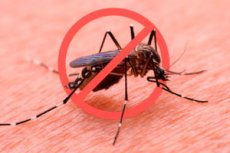New publications
When Medicine Saves from Bites: How a Drug for a Genetic Disease Attacks Mosquitoes
Last reviewed: 09.08.2025

All iLive content is medically reviewed or fact checked to ensure as much factual accuracy as possible.
We have strict sourcing guidelines and only link to reputable media sites, academic research institutions and, whenever possible, medically peer reviewed studies. Note that the numbers in parentheses ([1], [2], etc.) are clickable links to these studies.
If you feel that any of our content is inaccurate, out-of-date, or otherwise questionable, please select it and press Ctrl + Enter.

Here's a surprisingly fresh idea for combating "biting" disease carriers - using... an old medicine. A team from the Liverpool School of Tropical Medicine has shown that nitisinone, a well-known drug for treating rare tyrosine metabolism disorders, can kill even insecticide-resistant mosquitoes if they simply land on a treated surface. And it works specifically on "well-fed" females - immediately after bloodsucking, when they most often rest on the walls of houses. The study was published in the journal Parasites and Vectors.
Why is this important?
In recent years, the decline in malaria has stalled, while dengue and other arbovirus infections are rapidly expanding their range. The main reason is the widespread resistance of mosquitoes to common classes of insecticides (such as pyrethroids). Products with a different mechanism of action are needed to bypass this resistance and “turn on” the effectiveness of nets and indoor spraying again.
What is nitisinone and what's the trick?
Nitisinone inhibits the enzyme 4-hydroxyphenylpyruvate dioxygenase (HPPD), a key step in the breakdown of the amino acid tyrosine. This is a vulnerability for blood-sucking insects: after a heavy bloodsucking, the flow of tyrosine in their intestines increases like an avalanche, and if the drain is “blocked,” toxic metabolites accumulate — the insect dies. Previously, it was shown that nitisinone is lethal to arthropods when it gets to them with the host’s blood (the so-called endectocidal approach). The new work has shown a more practical way: it is enough for a well-fed female to touch the treated surface with her paws — the drug penetrates the cuticle and starts the same lethal scenario.
What did the scientists do?
- Four β-triketone HPPD inhibitors (nitisinone, mesotrione, sulcotrene, tembotrione) were tested in so-called tarsal (through paws) bioassays. Only nitisinone showed reliable activity.
- Nitisinone was tested on three mosquito genera: Anopheles (malaria), Aedes (dengue, zika, chikungunya) and Culex (lyphatic filaria, arboviruses). Both "sensitive" laboratory lines and lines with multiple resistance to pyrethroids, DDT and carbamates were included. The result was equally high mortality among resistant and non-resistant lines.
- The exposure was given for an hour after bloodsucking - this simulated a real situation: a well-fed female sits on a wall treated with an insecticide (essentially simulating spraying of premises/IRS or covering parts of a net).
What does this mean for practice?
- New mechanism. Nitisinone is not a member of the current IRAC classes and does not target the nervous system but rather the blood metabolism. This reduces the risk of cross-resistance with insecticides already in use.
- Synergy with real tactics. The World Health Organization notes that the maximum effect of spraying internal surfaces is achieved precisely after the mosquito has drunk blood and sat down to "rest". Nitisinone hits this "window of vulnerability".
- Who does it kill? Both Anopheles, and Aedes, and Culex - that is, potentially one molecule can help against malaria and arboviruses at once.
Safety and sustainability in the environment
Nitisinone has been used in humans (including children) for decades to treat hereditary metabolic diseases; its side effects are mostly related to long-term systemic administration and elevated blood tyrosine levels, a scenario that is not consistent with short contact doses in vector control. Chemically, the compound is fairly stable and does not degrade rapidly during storage or in the field, a plus for field programs. Of course, this does not eliminate the need for a full environmental risk assessment and formulation for specific applications.
Important nuances
- Standard WHO sensitivity tests usually use unfed mosquitoes, which are more sensitive to pyrethroids than "fed" ones. The authors emphasize that new products need to be evaluated taking into account the physiology after bloodsucking, otherwise we underestimate the real doses/efficacy.
- Of the four related β-triketones, only nitisinone worked. This means that “class by name” is not a guarantee of effect; apparently, specific physical and chemical properties (penetration through the cuticle, retention, etc.) are critical.
What's next?
Formulation and field testing: select solvents/microcapsules/binders that will provide long-term residual activity on walls and meshes in hot/humid climates. 2) Resistance management strategy: alternation with other classes, combination with pyrethroids and PBO meshes, marker monitoring. 3) Regulatory pathway: nitisinone is already “known” to doctors and toxicologists, but formally vector control requires separate assessments - this may speed up, but will not cancel standard requirements.
Conclusion
The study offers a rare “double bonus” for vector control: a new biological technique (a hit to tyrosine metabolism after a blood meal) and a compound with a ready-made safety dossier. If the next steps – formulation and testing in houses and huts – confirm the lab results, nitisinone could become the missing link to nets and sprays, once again “out-terrifying” mosquitoes that have already learned to live with our older insecticides.
